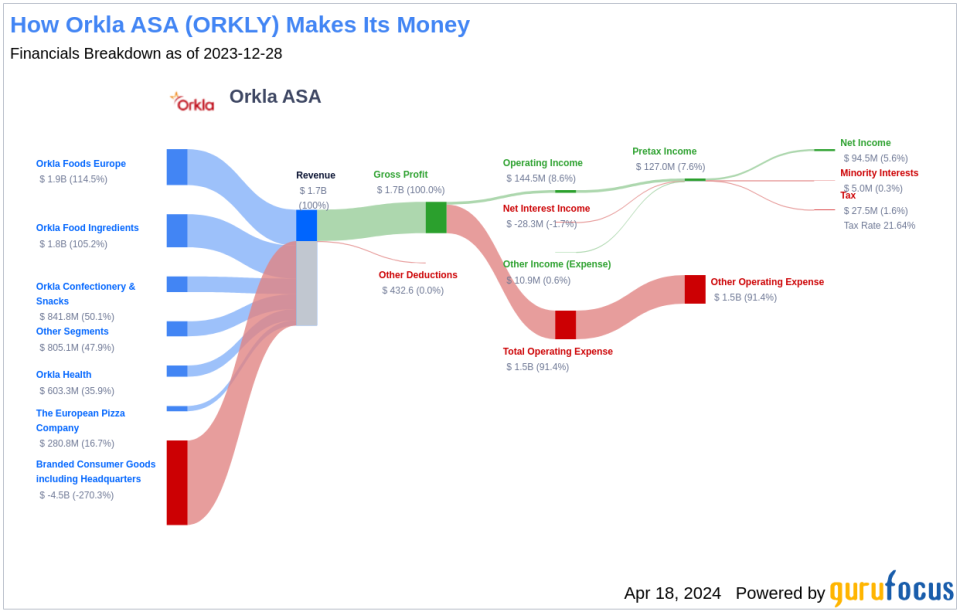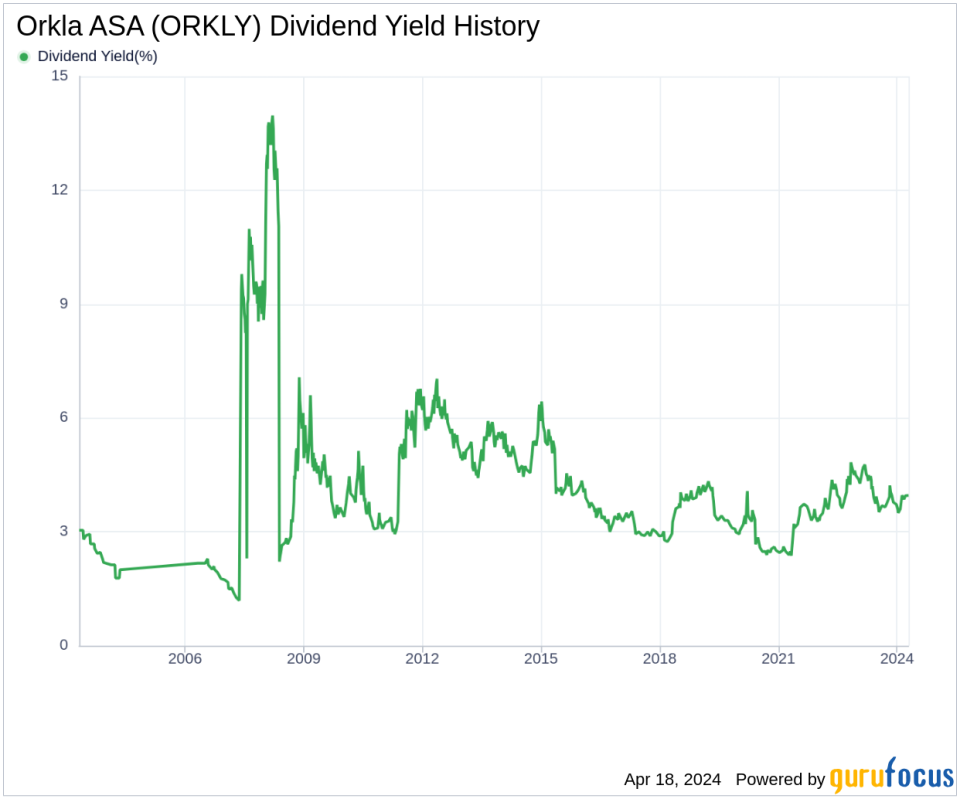Orkla ASA's Dividend Analysis
Assessing the Sustainability and Prospects of Orkla ASA's Dividend
Orkla ASA (ORKLY) recently announced a dividend of $0.56 per share, payable on 2024-05-13, with the ex-dividend date set for 2024-04-19. As investors look forward to this upcoming payment, the spotlight also shines on the company's dividend history, yield, and growth rates. Using the data from GuruFocus, let's look into Orkla ASA's dividend performance and assess its sustainability.
What Does Orkla ASA Do?
This Powerful Chart Made Peter Lynch 29% A Year For 13 Years
How to calculate the intrinsic value of a stock?
Orkla ASA is a branded consumer goods company, originally from Norway. Its segments include Orkla Foods Europe, Orkla Food Ingredients, Orkla Confectionery & Snacks, Orkla Health, Orkla India, Orkla Home & Personal Care, The European Pizza, Orkla House Care, Health and Sports Nutrition Group, Pierre Robert Group, and Lilleborg. It generates the majority of its revenue from Norway.
A Glimpse at Orkla ASA's Dividend History
Orkla ASA has maintained a consistent dividend payment record since 2006. Dividends are currently distributed on a yearly basis. Below is a chart showing annual Dividends Per Share for tracking historical trends.
Breaking Down Orkla ASA's Dividend Yield and Growth
As of today, Orkla ASA currently has a 12-month trailing dividend yield of 3.91% and a 12-month forward dividend yield of 7.78%. This suggests an expectation of increased dividend payments over the next 12 months.
Over the past three years, Orkla ASA's annual dividend growth rate was 4.90%. Extended to a five-year horizon, this rate decreased to 3.50% per year. And over the past decade, Orkla ASA's annual dividends per share growth rate stands at 1.80%.
Based on Orkla ASA's dividend yield and five-year growth rate, the 5-year yield on cost of Orkla ASA stock as of today is approximately 4.64%.
The Sustainability Question: Payout Ratio and Profitability
To assess the sustainability of the dividend, one needs to evaluate the company's payout ratio. The dividend payout ratio provides insights into the portion of earnings the company distributes as dividends. A lower ratio suggests that the company retains a significant part of its earnings, thereby ensuring the availability of funds for future growth and unexpected downturns. As of 2023-12-31, Orkla ASA's dividend payout ratio is 0.51.
Orkla ASA's profitability rank, offers an understanding of the company's earnings prowess relative to its peers. GuruFocus ranks Orkla ASA's profitability 9 out of 10 as of 2023-12-31, suggesting good profitability prospects. The company has reported positive net income for each of year over the past decade, further solidifying its high profitability.
Growth Metrics: The Future Outlook
To ensure the sustainability of dividends, a company must have robust growth metrics. Orkla ASA's growth rank of 9 out of 10 suggests that the company's growth trajectory is good relative to its competitors.
Revenue is the lifeblood of any company, and Orkla ASA's revenue per share, combined with the 3-year revenue growth rate, indicates a strong revenue model. Orkla ASA's revenue has increased by approximately 13.00% per year on average, a rate that outperforms approximately 67.94% of global competitors.
The company's 3-year EPS growth rate showcases its capability to grow its earnings, a critical component for sustaining dividends in the long run. During the past three years, Orkla ASA's earnings increased by approximately 4.70% per year on average, a rate that outperforms approximately 46.37% of global competitors.
Lastly, the company's 5-year EBITDA growth rate of 9.70%, which outperforms approximately 57.48% of global competitors.
Next Steps
Considering Orkla ASA's consistent dividend payments, a solid dividend growth rate, a reasonable payout ratio, robust profitability, and favorable growth metrics, the company presents as a compelling case for value investors focused on dividend income. The future outlook appears promising, and the company's financial health suggests that it is well-positioned to continue rewarding shareholders with sustainable dividends. As investors consider adding Orkla ASA to their portfolios, they should also pay attention to market dynamics and the company's performance in upcoming quarters to ensure alignment with their investment strategy.
GuruFocus Premium users can screen for high-dividend yield stocks using the High Dividend Yield Screener.
This article, generated by GuruFocus, is designed to provide general insights and is not tailored financial advice. Our commentary is rooted in historical data and analyst projections, utilizing an impartial methodology, and is not intended to serve as specific investment guidance. It does not formulate a recommendation to purchase or divest any stock and does not consider individual investment objectives or financial circumstances. Our objective is to deliver long-term, fundamental data-driven analysis. Be aware that our analysis might not incorporate the most recent, price-sensitive company announcements or qualitative information. GuruFocus holds no position in the stocks mentioned herein.
This article first appeared on GuruFocus.

 Yahoo Finance
Yahoo Finance 

